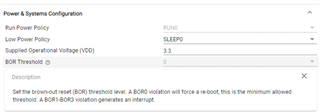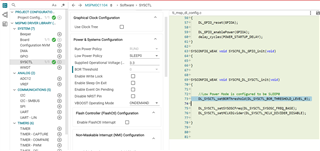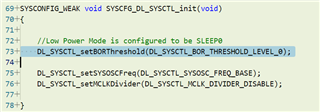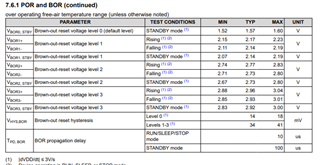Other Parts Discussed in Thread: SYSCONFIG
Tool/software:
Hi experts,
I am using MSPM0C1104.
in sysconfig, BOR Threshold is disable and cannot be modified.

I would like to know how to adjust the BOR Threshold setting.
thanks
This thread has been locked.
If you have a related question, please click the "Ask a related question" button in the top right corner. The newly created question will be automatically linked to this question.
Tool/software:
Hi experts,
I am using MSPM0C1104.
in sysconfig, BOR Threshold is disable and cannot be modified.

I would like to know how to adjust the BOR Threshold setting.
thanks
Hi Robin Moon
I think this is the limitation of current version sysconfig on MSPM0C1104 device

Please go to the source code and update the code to level 1 and so on

Please check the spec on BOR level on device data sheet

Thanks!
Hi Li.
The ti_msp_dl_config.c file is an automatically generated file by sysconfig settings.
Please tell me how I can update it from the source.
thanks
Hi Robin,
You can modify the BOR threshold right after the initialization in the main function. The screenshot of the MSPM0C1104_TRM for BOR configuration as shown below, there are mainly two steps required:
1. Select the desired value in the LEVEL field of the BORTHRESHOLD register in SYSCTL.
2. Activate the threshold set in the LEVEL field by setting the GO bit in the BORCLRCMD register.

Here is a simple example code. In addition, you can also handle the BOR interrupt in "NMI_Handler", the code framework can be referred to as follows.
int main(void)
{
SYSCFG_DL_init();
/* BOR Threshold Setting */
DL_SYSCTL_setBORThreshold(SYSCTL_BORTHRESHOLD_LEVEL_BORLEVEL2);
DL_SYSCTL_activateBORThreshold();
while (1) {
}
}
void NMI_Handler(void) {
if(DL_SYSCTL_NMI_IIDX_BORLVL == DL_SYSCTL_getPendingNonMaskableInterrupt()) {
}
}
Best Regards,
Peter